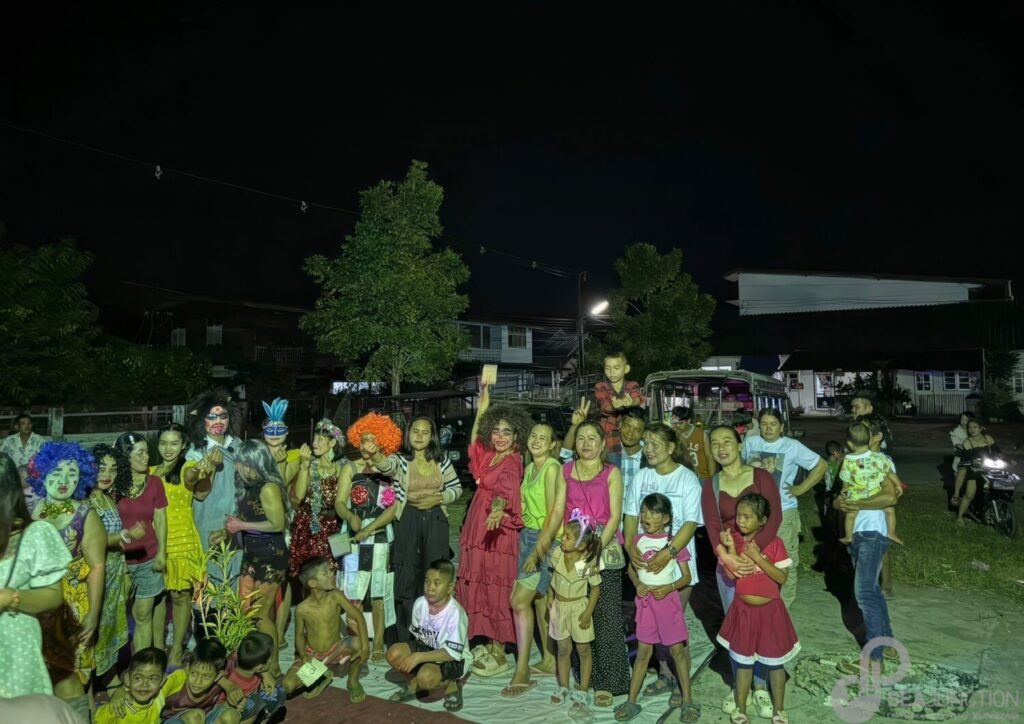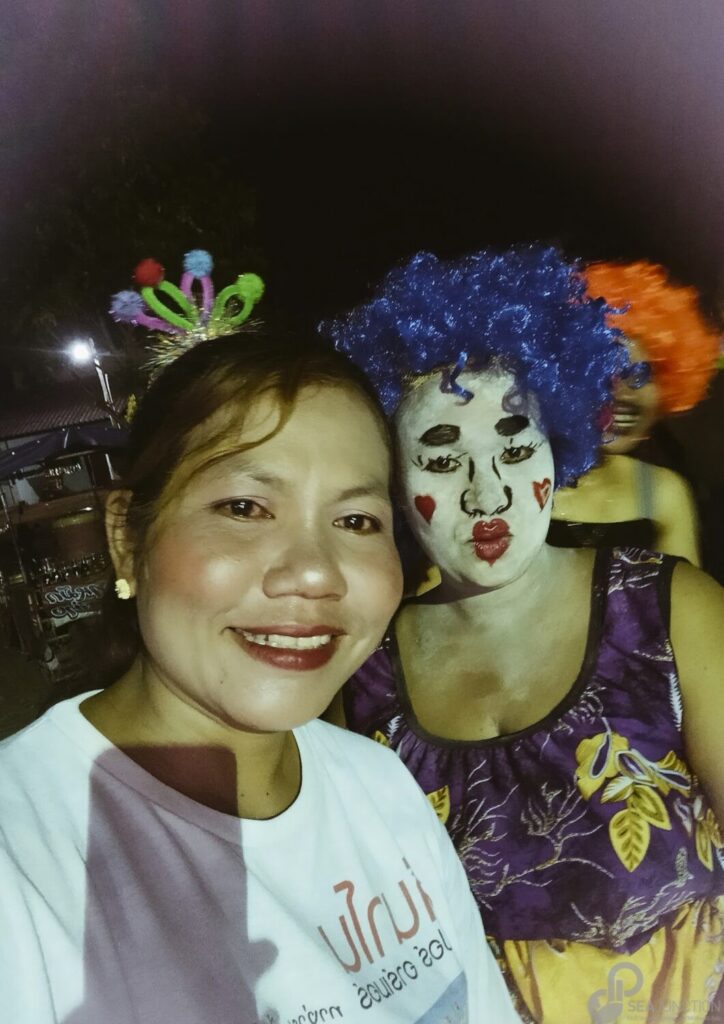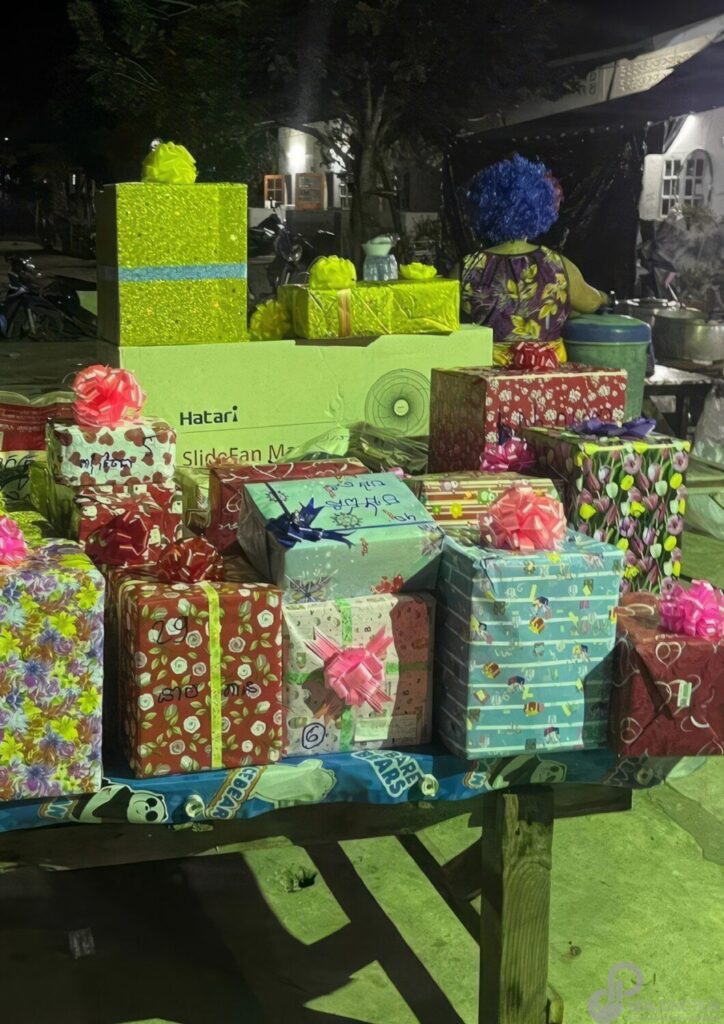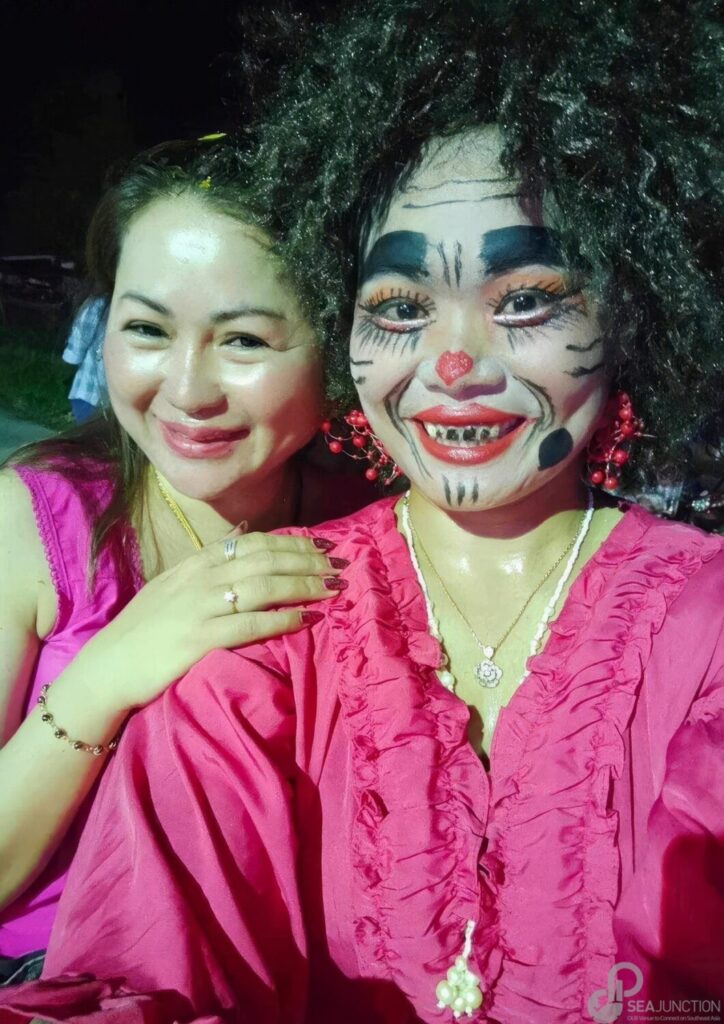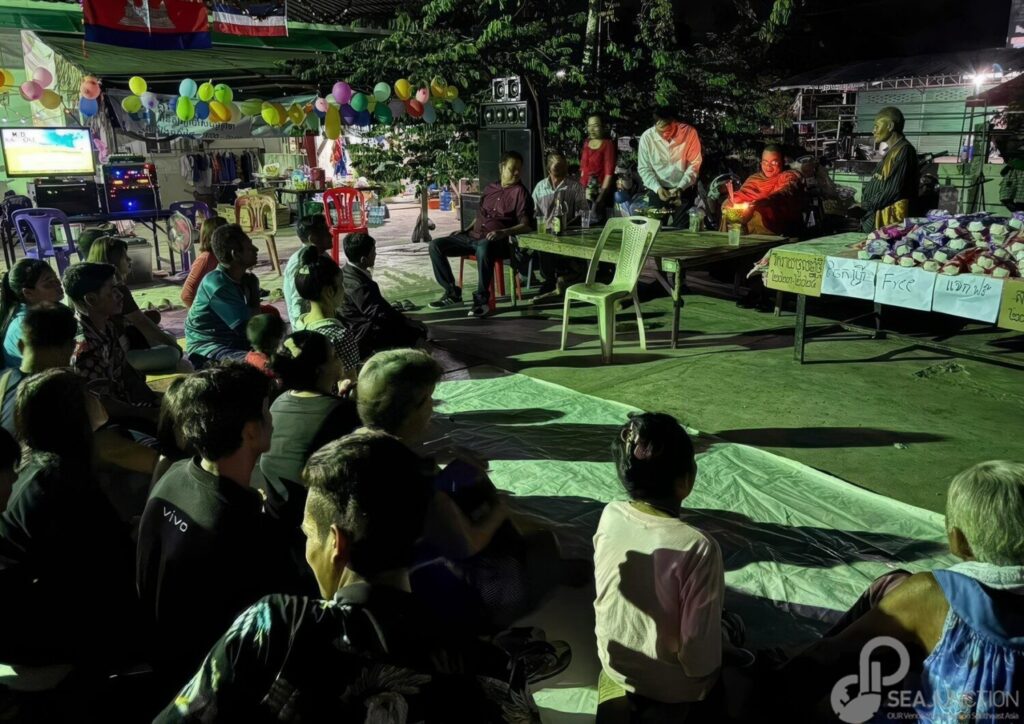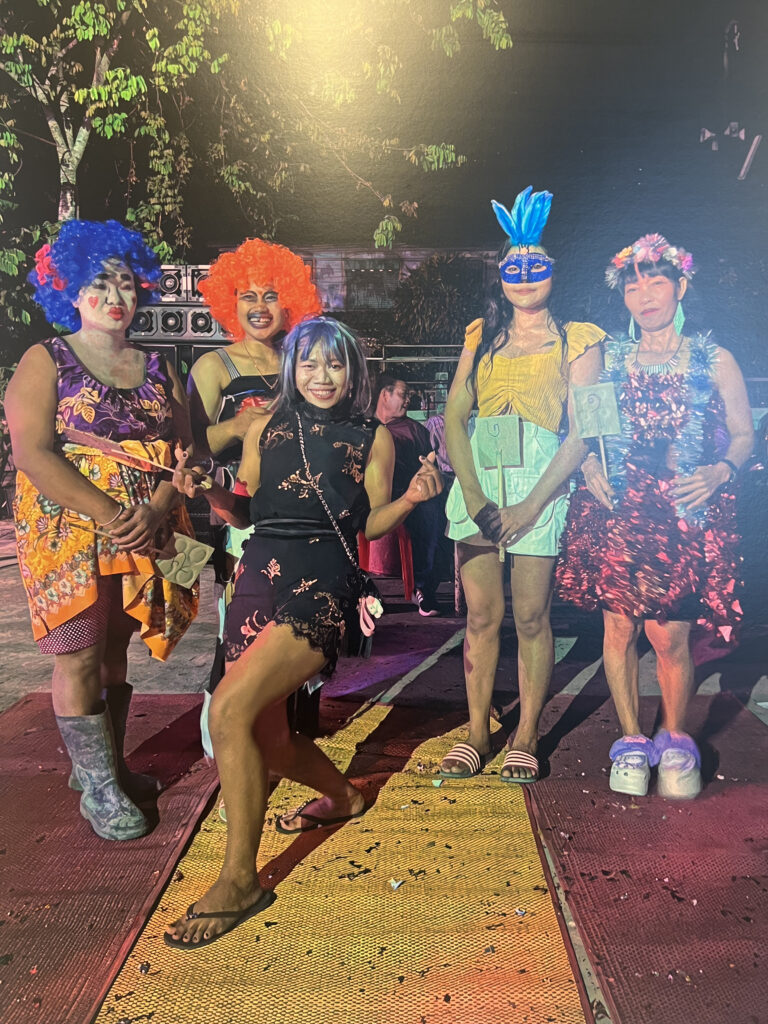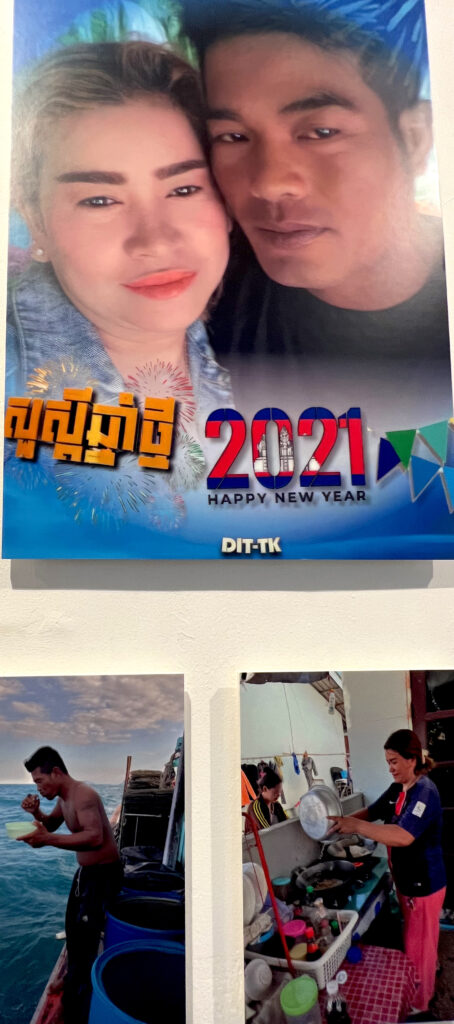Not just Labor // Thailand’s Fisheries Migrant Communities Show their Life
BANGKOK // Migrant workers from Cambodia and Myanmar who are currently employed in the fishing and seafood packaging industry in the south of Thailand, showcased their photo stories. These pictures shot with their mobile phones were shown by SEA-Junction in an exhibition at the Bangkok Art and Culture Centre (BACC) in May 2024. They capture their daily lives, showing challenging, entertaining, or mundane moments. They also depict interactions with their natural and social environments, as well as their dreams and hopes for the future.
The exhibition’s message, reflected in the title, emphasises that migrants are more than just workers; they are individuals like anyone, with their daily routines, their joys and their worries, and a strong resolve to make a living even as they have to face various forms of exploitation. The photos also illustrate how migrants have embraced Thai society, highlighting the importance of introducing integration policies.
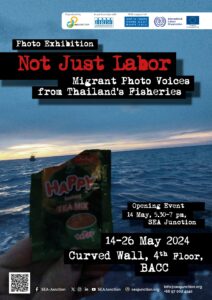 The collaborative idea came from Rosalia Sciortino, founder and director of SEA-Junction and the Ship to Shore Rights South East Asia initiative by ILO (International Labour Organization), funded by the European Union.
The collaborative idea came from Rosalia Sciortino, founder and director of SEA-Junction and the Ship to Shore Rights South East Asia initiative by ILO (International Labour Organization), funded by the European Union.
“We have seen a lot of pictures of migrant workers at work, like on the boat, but we hardly see the other aspects of their lives, how they live, how they enjoy lives or entertain themselves after the hard work, how they travel around, etc”, said Dr. Rosalia Sciortino. “We made an open call on social media for migrant workers to send pictures they took of their daily lives and what was important for them. We partnered with Human Rights Development Foundation to help spread the word in communities. One Cambodian and two Burmese facilitators coordinated the project with migrant workers communities from PhangNa, Phuket, Ranong and Chanthaburi.”
This exhibition celebrates migrants’ identities, actions, and unique qualities that are essential to our shared humanity, rather than portraying them as anonymous figures. Recognizing and valuing migrants’ journeys and hopes is essential for creating a society that is fair and inclusive, respecting the dignity of all individuals.
Dr Rosalia Sciortino added, “Our aim is to show the gap between the policy side that views migrants only as temporary workers and the reality that they are an actual part of the social fabric. We need to start talking about integration in Thai society, that has to become more inclusive. At the moment there is no discussion. Policy should change because for now there are not many efforts to include non-Thai people into the health and education system. There should be more facilitation of language skills and capacity building, and a recognition that Thai society is already diverse and pluralistic”.
Sayan Chuenudomsavad is a documentary photographer residing in Bangkok. He provided photographic guidance to the workers who participated in the project and selected the pictures to be displayed at the exhibition.
“The project aimed to bridge gaps and foster connections. Migrant workers play a crucial role in Thailand’s economy, especially in sectors like fisheries. However, it often feels like we operate separately, without truly understanding each other. I want to create opportunities for Thais and migrant workers to meet and learn from each other. The photos on migrants’ phones may seem simple, but they are powerful tools that can transcend time, place, and distance to achieve this goal”.
Sayan mentioned that the amateur photographers took those pictures casually, but they turned out to be really meaningful and could demonstrate everything about their lifestyle.
“Just by looking at these pictures, you can see how they live. After I guided them on how to capture their own stories through images, they took so many photographs that I could not count in total. I focused on storytelling tips rather than photographic techniques, asking them what stories about themselves they wanted to tell. Then I selected a set of photos and put it into a series that conveyed those stories. I found some interesting photos, of wedding ceremonies, funerals, and New Year parties, of fellow migrant workers in their network lending hands and helping each other in those happy events and hard times. They did not realise how it could help in the greater scheme of things. Even though they looked so ordinary to them, for outsiders, these photos touched on so many feelings.”
Sayan added, “Sometimes they were only scenery photos, sunsets, sunrises, blue skies or twilight skies. He or she told me that there was no story in it, just their feelings and appreciation of nature’s beauty that drove them to pick up their phones to capture the moment. I picked some of these photos to show the other aspects of the migrant workers, who worked so hard but were still full of an artistic sense”.
There is one message that he wanted to give to all the people coming to look at the pictures.
“It is simply, “Pleased to meet you” I wanted people who visited the exhibition to see these photos and kind of wanted to say this, and hopefully the migrant workers could also say “Pleased to meet you too” back. This is the starting point to learn about each other. I only knew that the migrant workers come to work in Thailand, be on the boat for several days, get back to the shore for a few days, and then go back to the sea again.
After working with them on this project, I have learned that they are not only labourers, but we do share similar aspirations such as;
We’re looking for a better life, a better future.
We entertain ourselves after a long day of hard work, laughing, fighting, crying, meeting and saying goodbye.
This is the message.”
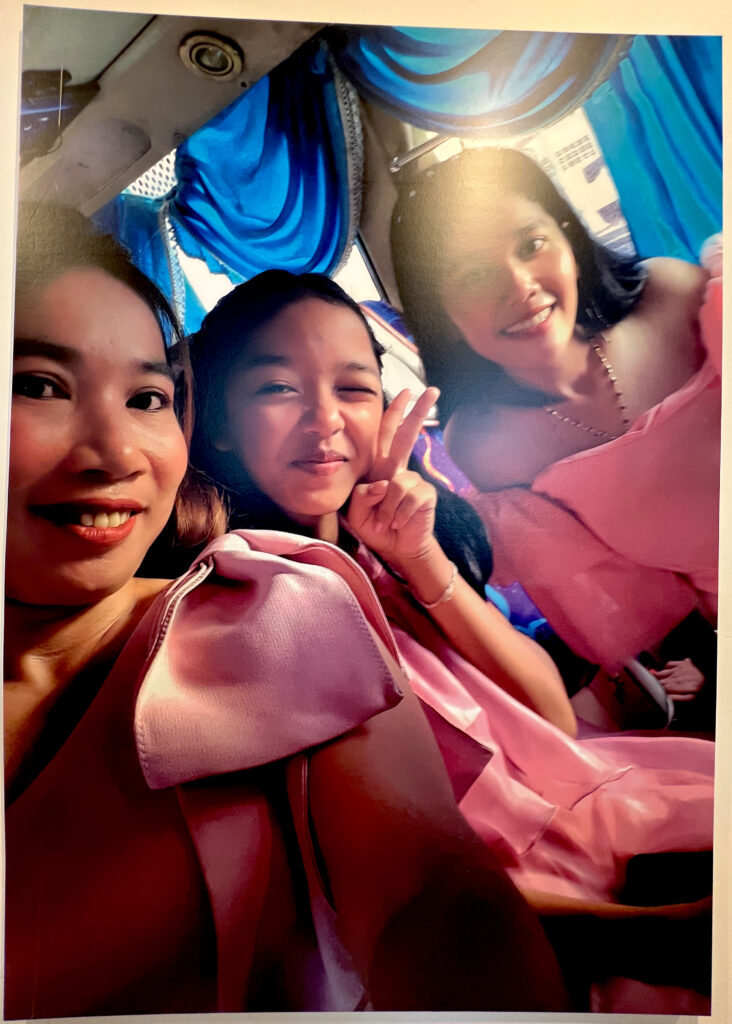
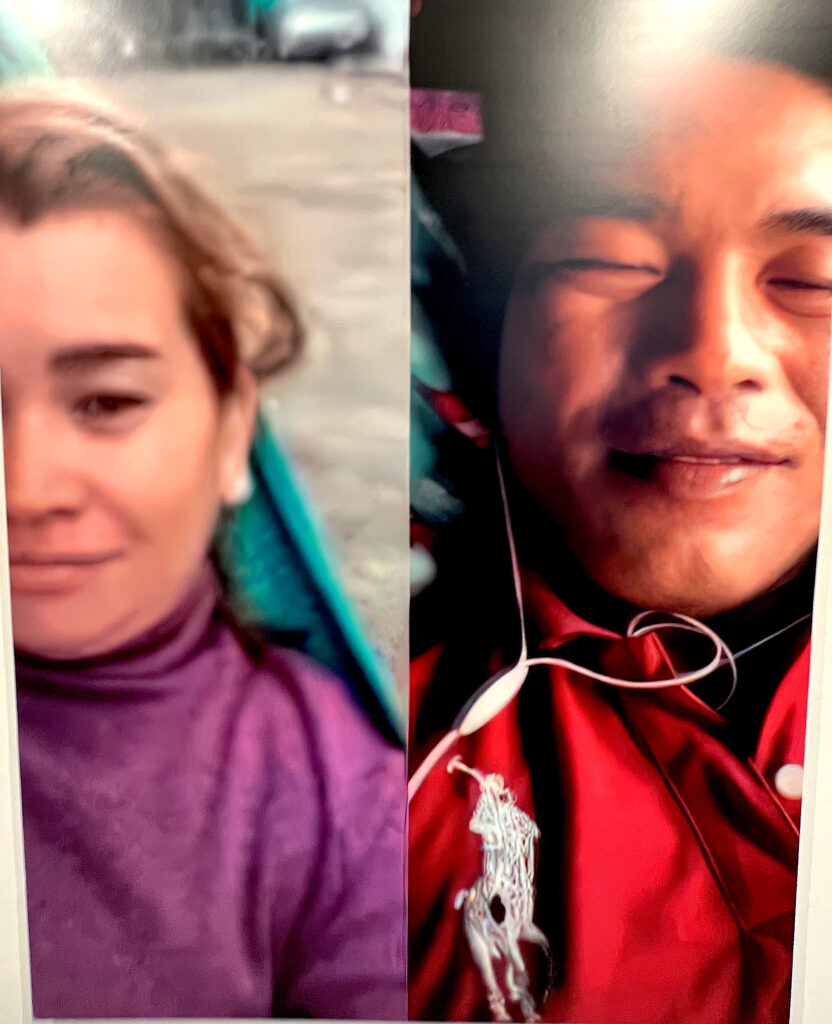
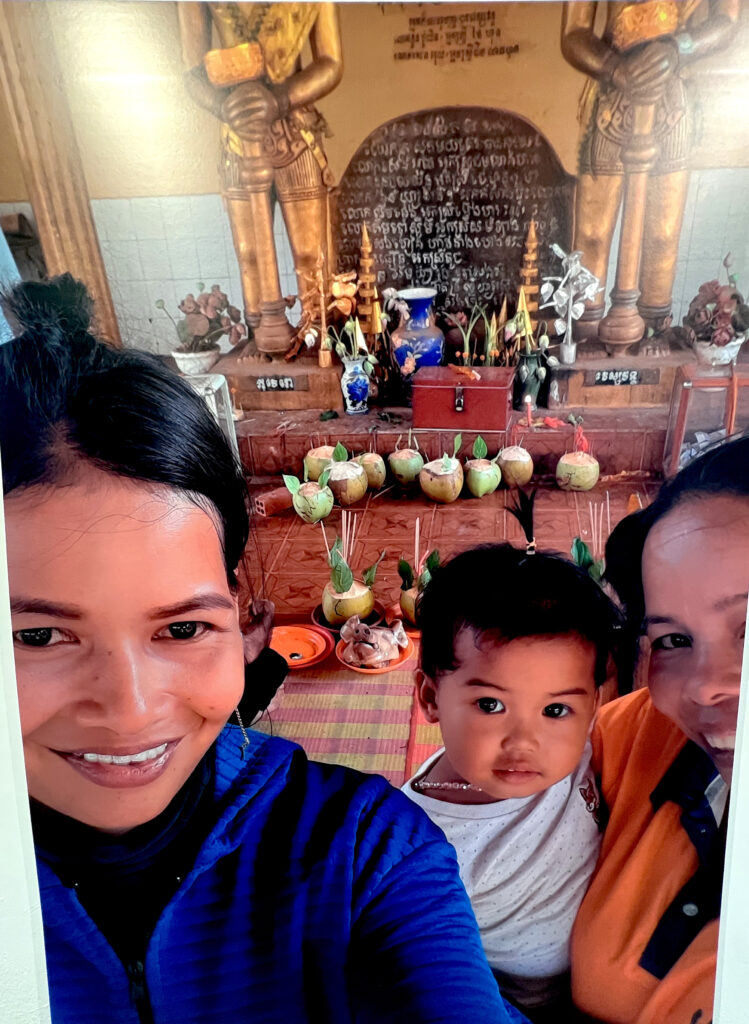
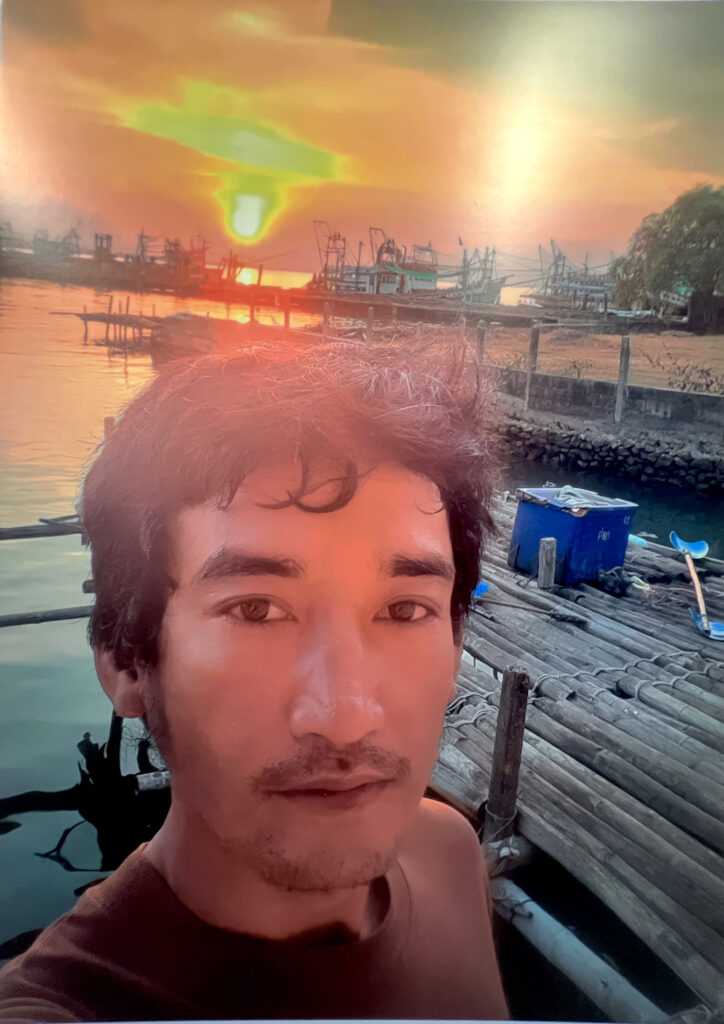
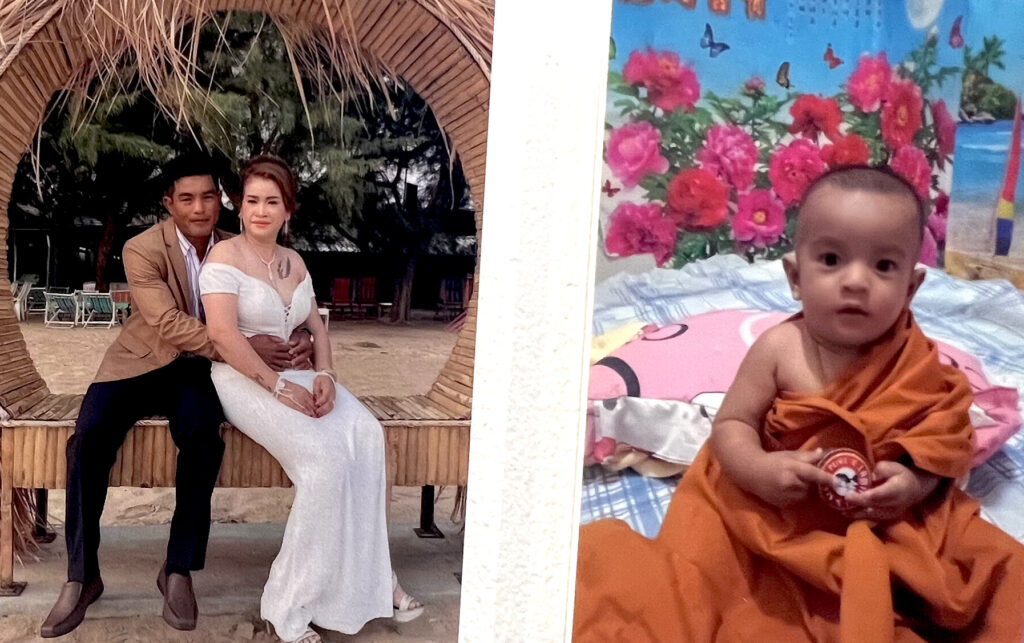
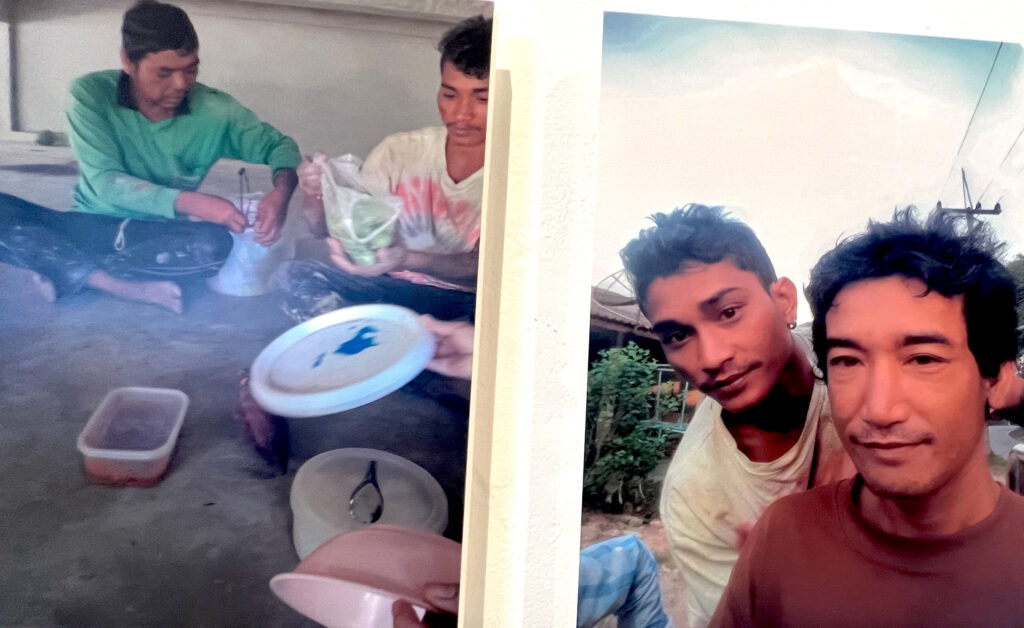
Organising a photo exhibition of Cambodian and Burmese migrant workers together was not an easy task. When talking to migrant workers at first about the idea of this exhibition, their interest was limited as they felt a lack of self-confidence. They thought that no one would want to listen to their stories.
Sayan explained, “We all have stories of our own to tell. Some interesting stories to share, some stories we feel better keep to ourselves. At first, the workers, who mostly spent their time on routine labor, felt confused about who was going to listen to their stories, if anyone. I tried to encourage them, telling them that many people would like to hear about their everyday life. And as I was attentively listening to them and hearing the stories behind the photos, this helped them feel more relaxed. Like all of us, they are happy when someone listens to what they are saying”.
People employed in fisheries work hard for a very low pay. They have to deal with difficulties, such as recognition of and accessibility to their labour rights as well as to public services.
For instance, women who clean off the skin of crabs have to sit for many hours to do a very tedious job. But they are only paid by the kilo of skinned off crab. They can manage between 2 and 7 kg maximum per day and get 70 THB per kilo, probably from the same person who provides the crabs. As their workplace is their home, they have to live surrounded by piles of crab skin in their houses. On top of those harsh conditions, they struggle to get ‘pink cards’ – identity documents initially issued to stateless people or people who have ‘alien’ status (according to the Thai state terminology), that is non-Thai citizen – and enrol their children at school.
“One can also see the challenges from their perspective: the low salary, the risks of the job, the fact that their choice of a job is being restricted by how much money they would get from it, even if they don’t like or are scared of this job,” commented Rosalia Sciortino.
In April 2024, the Foreign Workers Administration Office, Department of Employment, reported a total of 3,326,034 foreign workers legally employed in Thailand. Of these, 2,302,459 were from Myanmar and 448,967 were from Cambodia.
Burmese and Cambodian workers share commonalities such as their faith, as most of them follow Buddhism. They consider visiting temples to make merit an important tradition, even after moving to work in Thailand. They often schedule visits to temples where they can find spiritual comfort, especially temples hosting Burmese or Cambodian monks or built with familiar architecture. Many Burmese also wear their traditional clothing when they go to temples.
Some Cambodian and Burmese workers in Thailand are married to Thai citizens, and their children were born here. Some work as tattoo artists, some invite other communities to their wedding celebrations or New Year parties, blending their cultural traditions with those of Thailand.
The exhibition is made of short stories straight to the point, heart-touching quotes paired with strong visuals, and the prints are different sizes according to the resolution of the phone the pictures were taken with. This exhibition is actually the story of one community where migrant and local workers alike share everything in common as humans.
For Sayan, “the exhibition could be the first step to realise that we – Thai people and migrant workers – live together. Then it’s so important to learn that we share things in common as human beings. This would be the starting point to let us talk more about migrant workers policies.”
Dr. Rosalia Sciortino’s aim is “to show the public that they live in parallel worlds. Most people in Thailand see them as cheap service providers but they know nothing about their private lives. This project is a way to learn about their living conditions, their challenges regarding healthcare and childcare, their way of celebrating, working on a shrimp boat, etc.”
The presentation attached to the exhibition is also a reminder to the public of the crucial economic role played by those working in Thai fisheries: “Globally, trade in fish products continues to reach record highs and Thailand has emerged as a major supplier, with the value of its seafood exports reaching US$6 billion in recent years. And a significant contribution to the industry’s growth is made by the migrant labour force. The new photo exhibition displaying their “voices” through the photographs they took invites you to look into their human sides.”
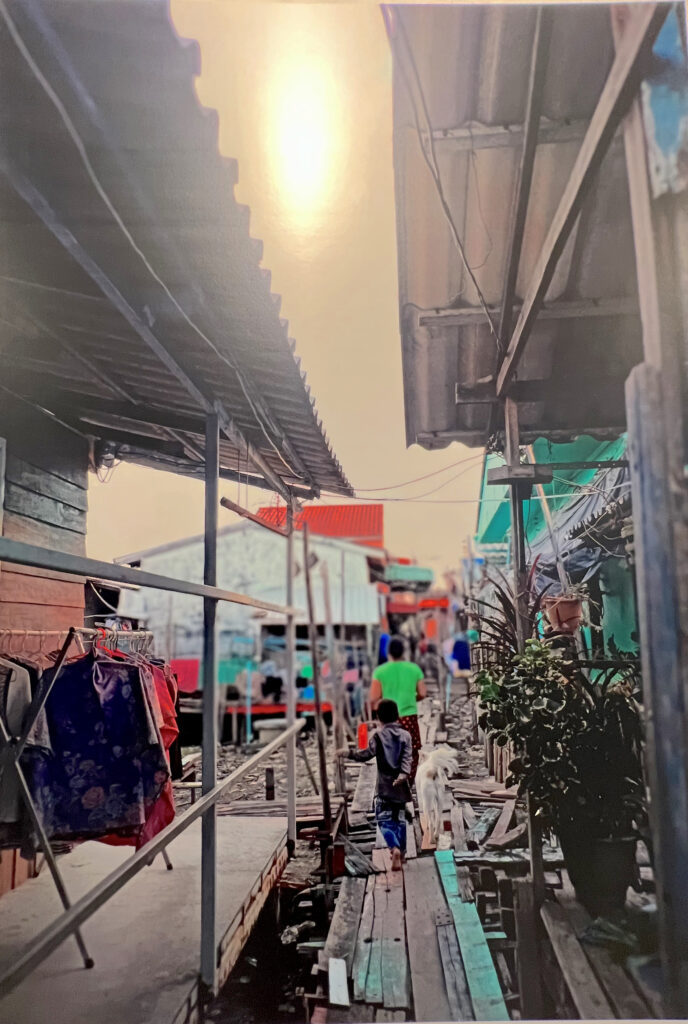
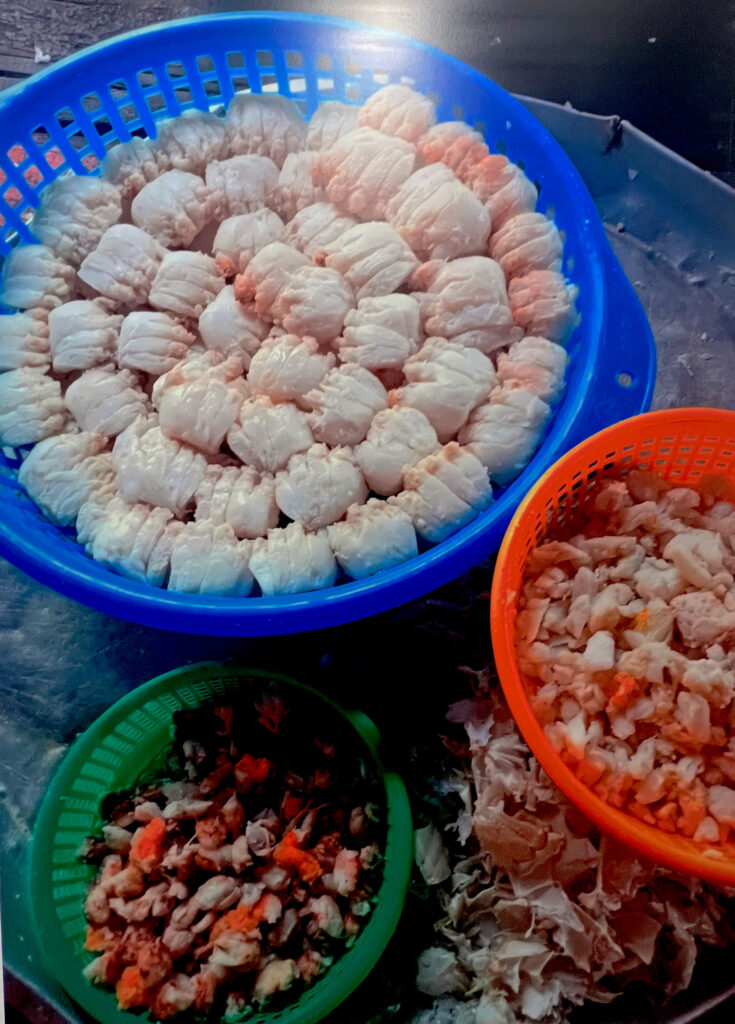
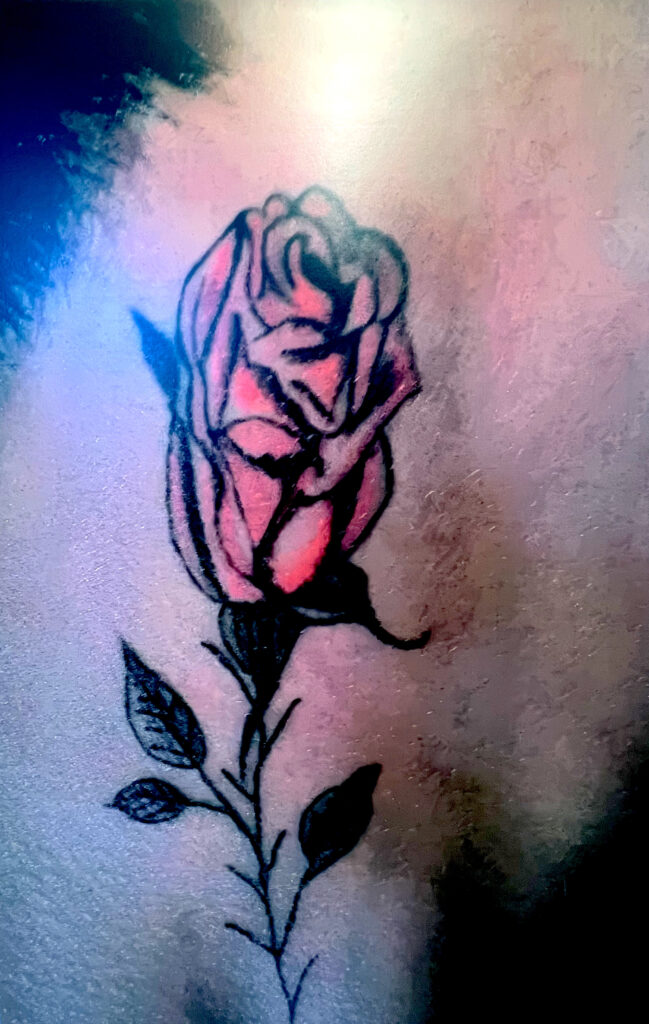
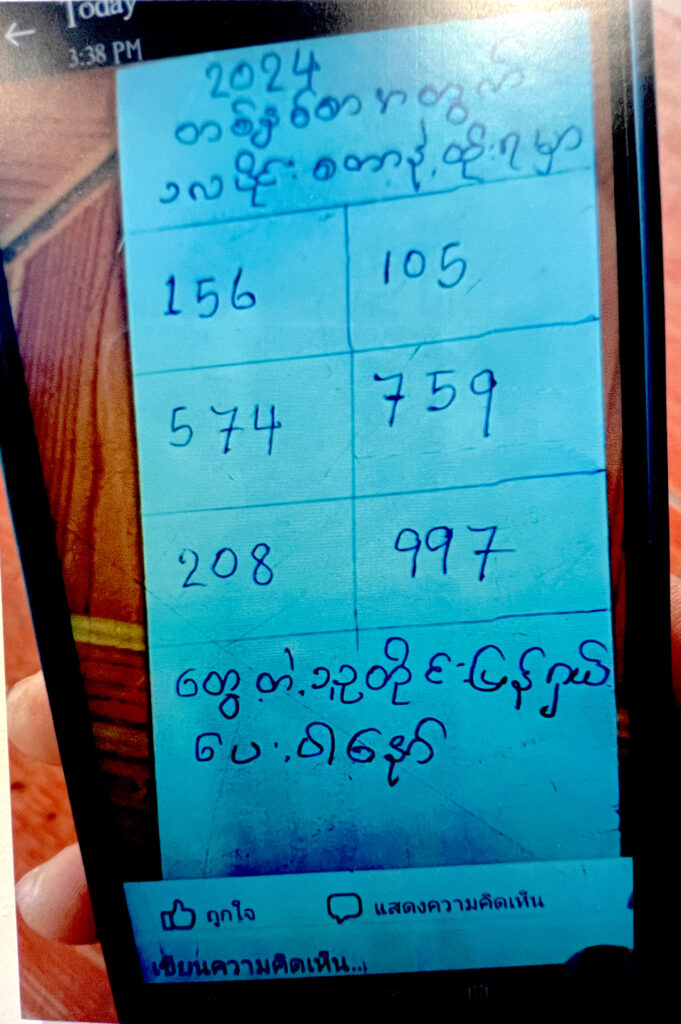
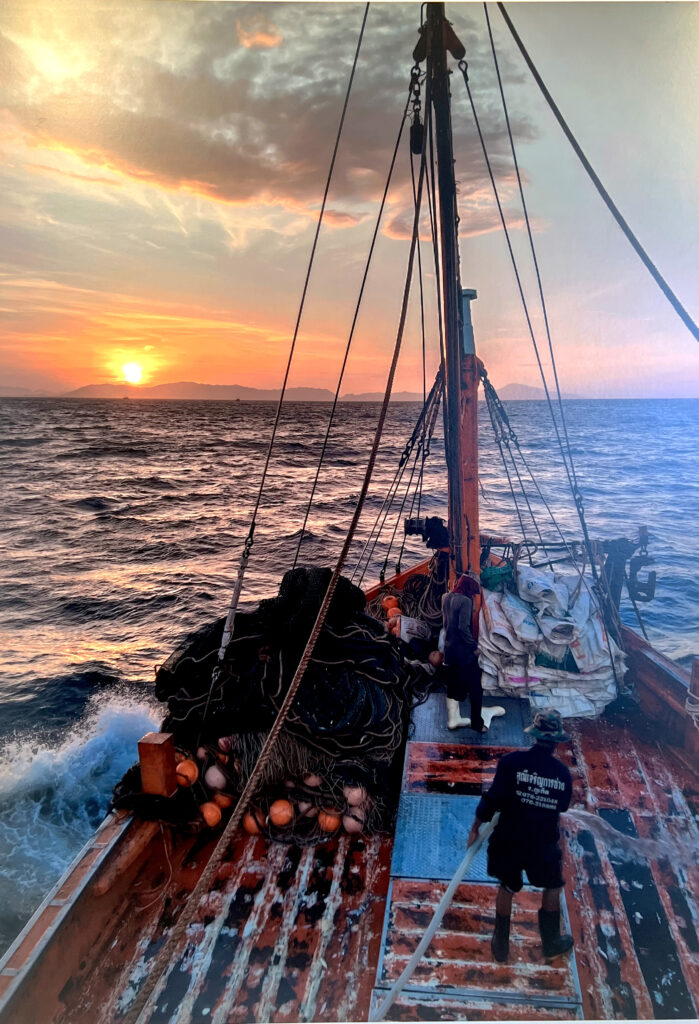
The exhibition called “NOT JUST LABOR; MIGRANT PHOTO VOICES FROM THAILAND’S FISHERIES” was shown at the Curved Wall on the 4th floor of BACC from May 14 to 26, 2024.
It will be shown again at the BACC (Pop_Up) Event at Sea Con Square in October 2024, you can follow SEA-Junction page for more updates. You can learn more about SEA-Junction vision and mission in this episode by Insight Myanmar podcast.
PORTFOLIOS // Here are some of their stories
1 / Pyae Sone Aung /
“I am 18 years old. My mother has been in Thailand for 30 years now. I tried to go to Malaysia to find a job but was caught as I had no documents and spent 9 months in prison before being sent back to Myanmar. In Myanmar, I worked in a factory producing aluminum windows and doors since I was 16 years old.
I have been in Thailand for almost a year now. A month ago, I started working on a black trawler boat. The views from the boat are astonishing and I wish others could see the scenery. When I was free on the boat, I quickly took a snapshot on the phone and immediately posted it on Facebook for people to enjoy.”
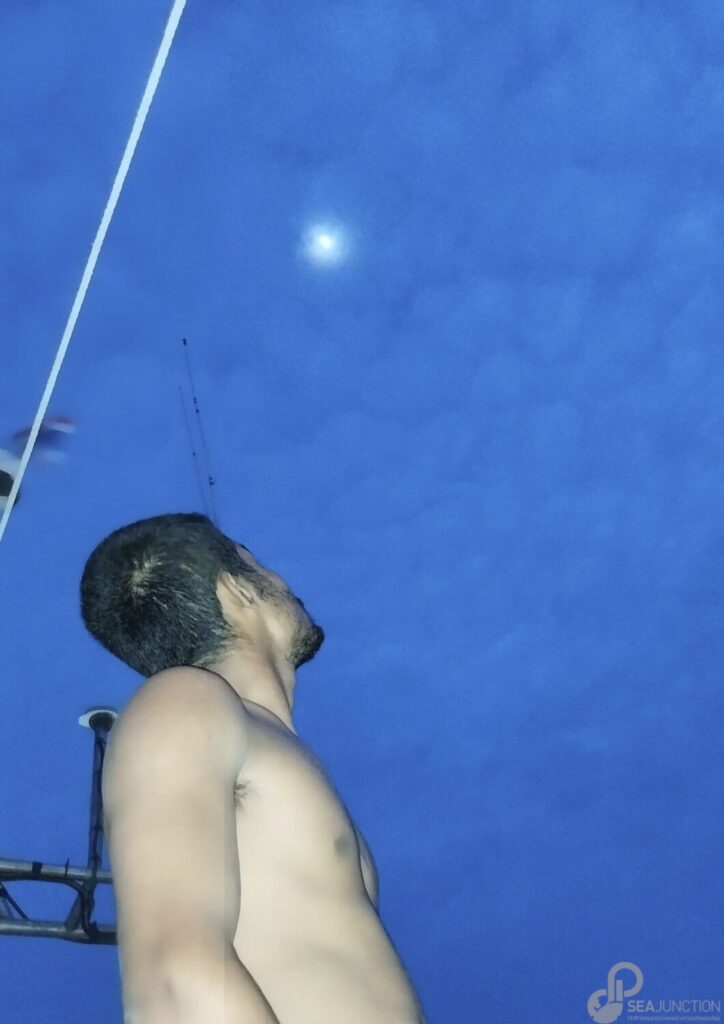
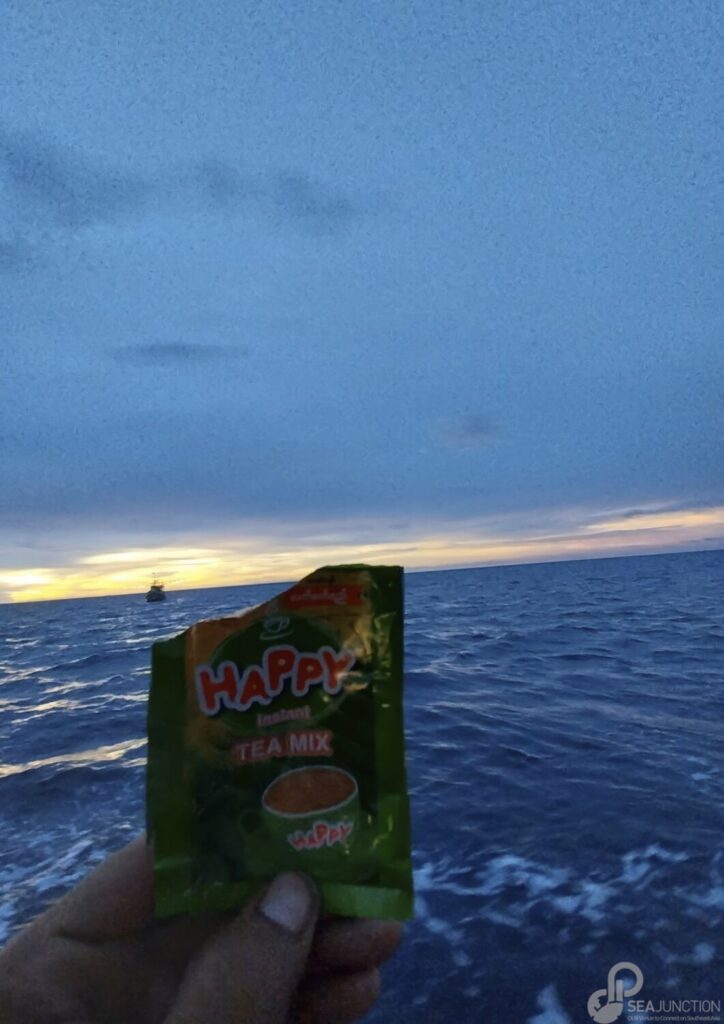
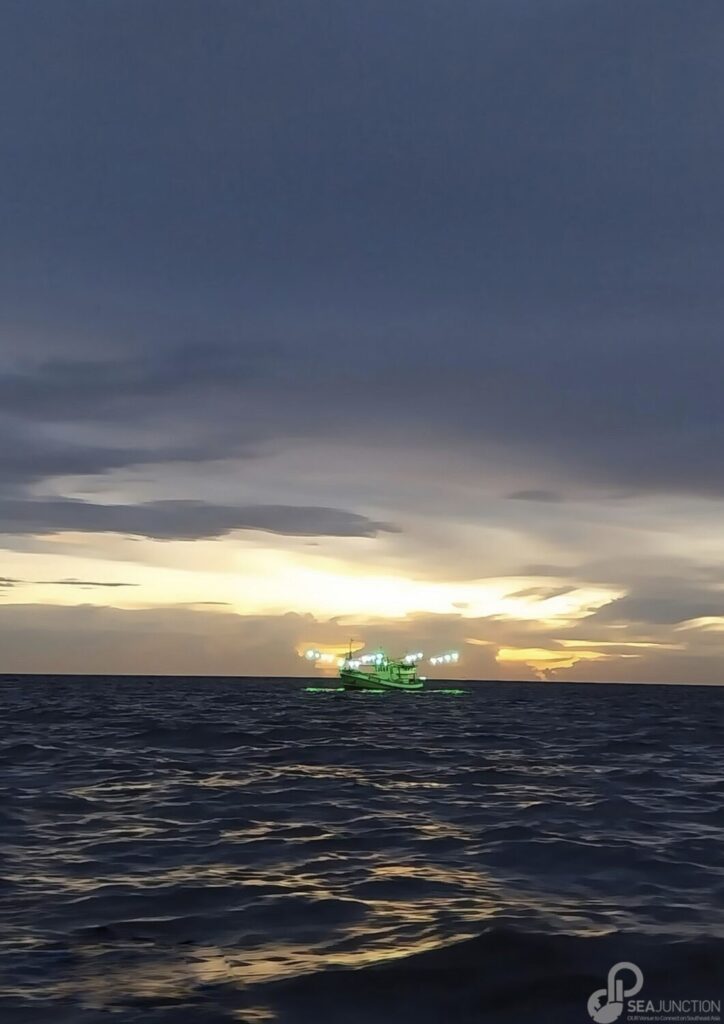
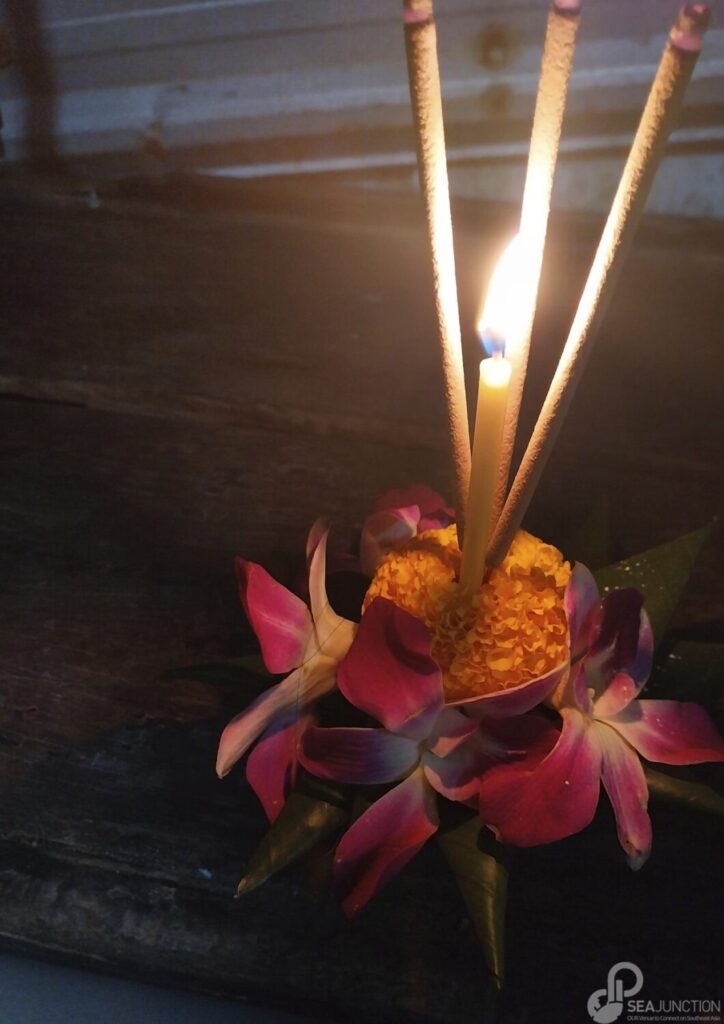
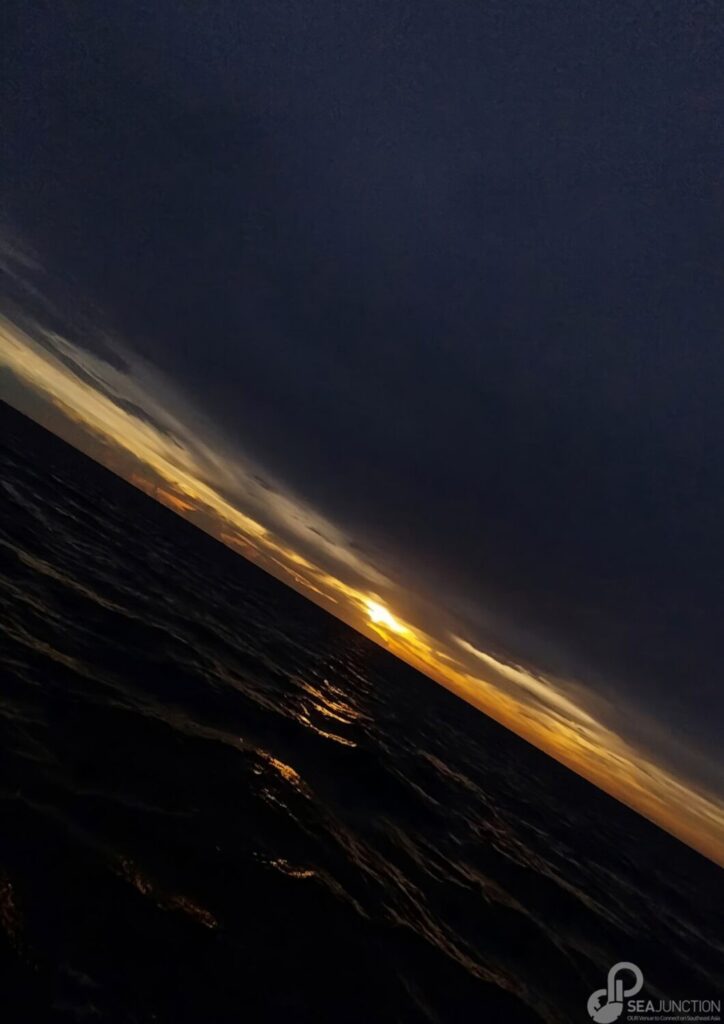
2 / Som Rong /
“I am Som Rong, a 34-year-old Cambodian migrant worker. Here I talk about my friend’s funeral. She was also a migrant working in the fishing industry. When she got sick, she moved to her mother’s room. We believe she got sick from the chemical used in the Longan plantation in Rayong where she worked before. Migrants who die in Thailand face a tragic fate because their relatives cannot attend the funeral, since they have no passports, and it is expensive. So, we just tell the relatives the sad news and they make merit in Cambodia.
“We organized the funeral in the Thai way, which is similar to our way. After the cremation, we cannot bring her ashes to the rental room as the owner is a good guy, but he is very superstitious. We put her ashes in an urn under the temple’s tree. The mother would like to bring the urn to Cambodia, but she is not sure if she can go, so she may give it to friends or other relatives to carry when they go back to Songkran. Not all migrant workers can or dare to bring the remains of the deceased back, most would just scatter the ashes in the sea.
The funeral only lasted one night to minimize the expenses and we cremated her the next day. There was also a tie-cutting ceremony, separating her from her husband and unleashing her from this world like we do in Cambodia. The owner of the squid vessel for whom she had worked for a long time also came to attend the funeral. He also cared for her when she fell sick in Rayong during COVID-19. Her husband is now working for him. The chair of the fishing association of Chanthaburi also attended the funeral. Migrant friends helped cover the costs of her funeral.”
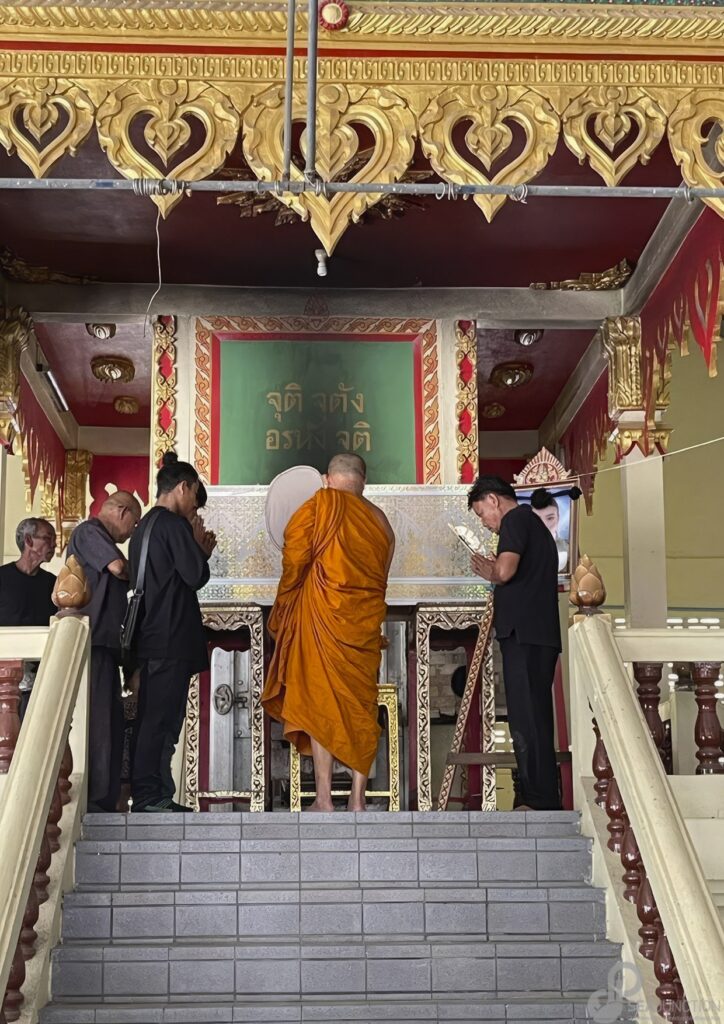
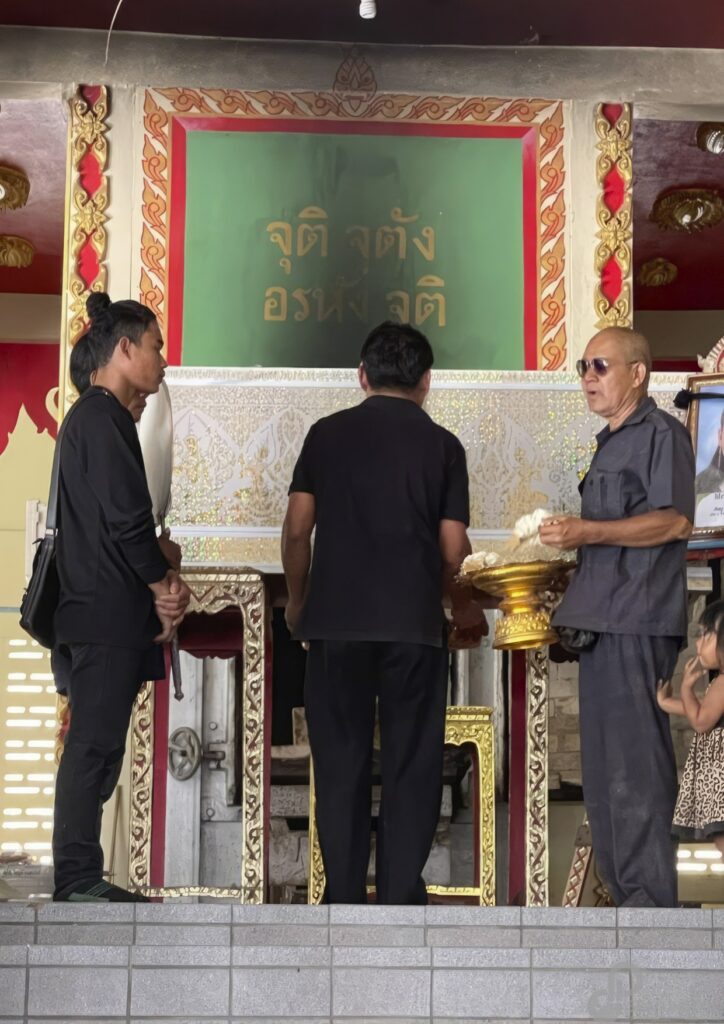
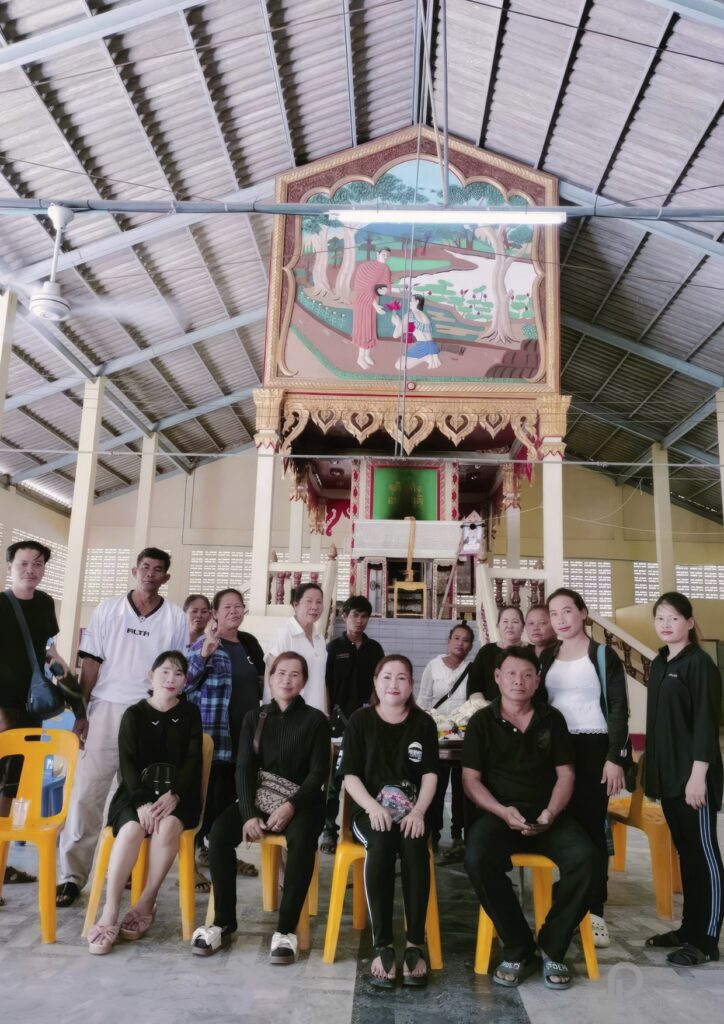
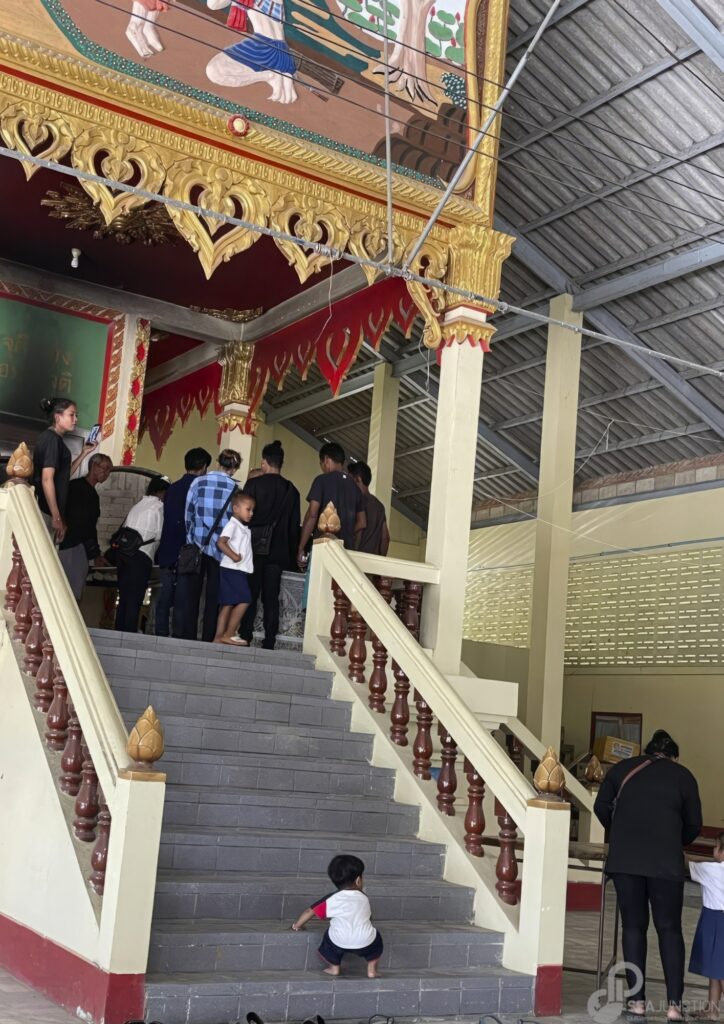
3 / Ma Yu Yu /
“I am from Dawei and I am now 40 years old. I have been in Thailand for more than 10 years, mostly in Phuket. Before COVID-19 I could travel to Dawei, but now it is difficult. I used to carve the crab before recently quitting the job to become a housemaid. Carving crab was very tiring, as it required concentration and I had to sit all day long. It hurt my legs and knees.
I have a son and two daughters. The girl in the picture is my youngest. She has been suffering from heart valve regurgitation since birth. The hospital where she was born rejected the case, citing her serious medical condition and because we do not have money or insurance and treatment is very costly. Luckily, a non-governmental organization helped us get a migrant health card. That is how she continues to receive the treatment and is able to live a normal life. Now, she is 3 years old and still needs to go to the doctor regularly.”
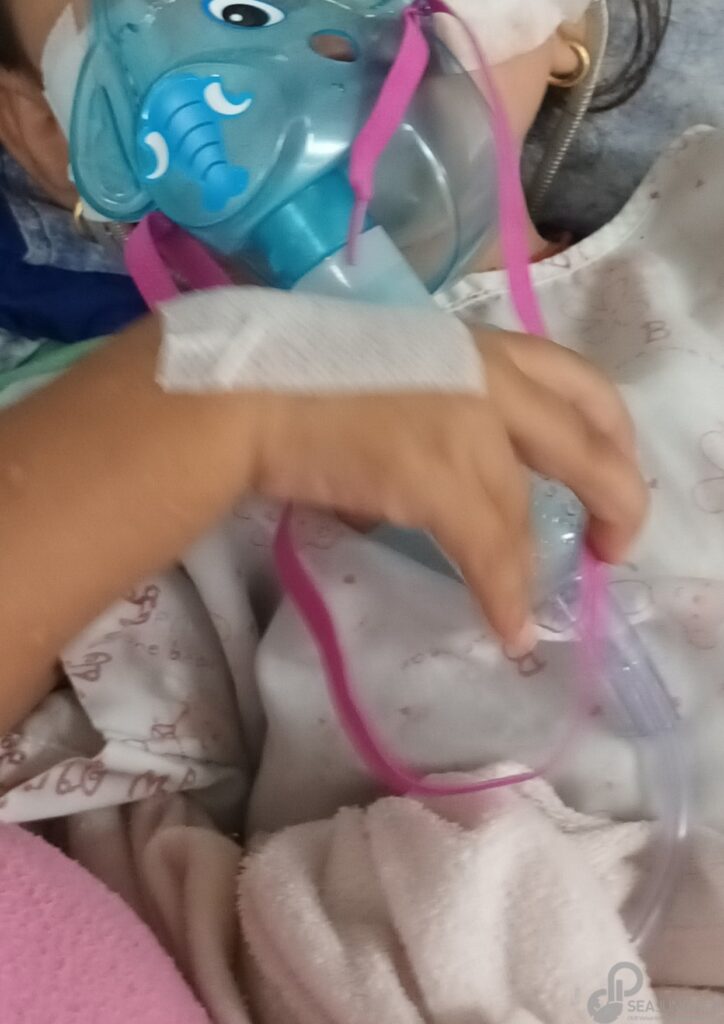
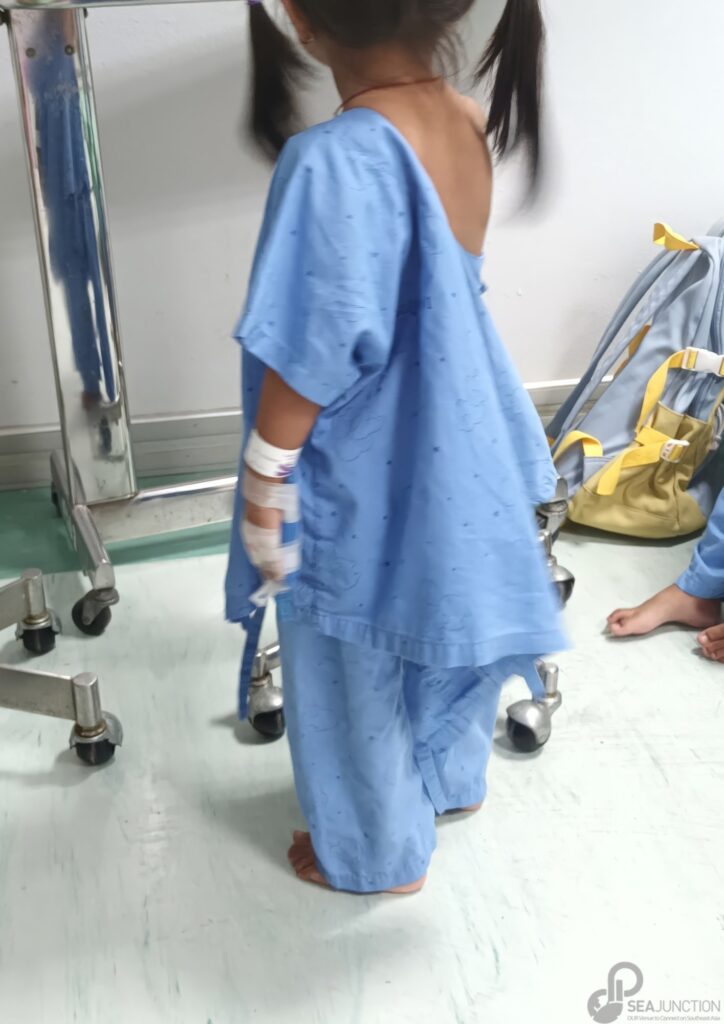
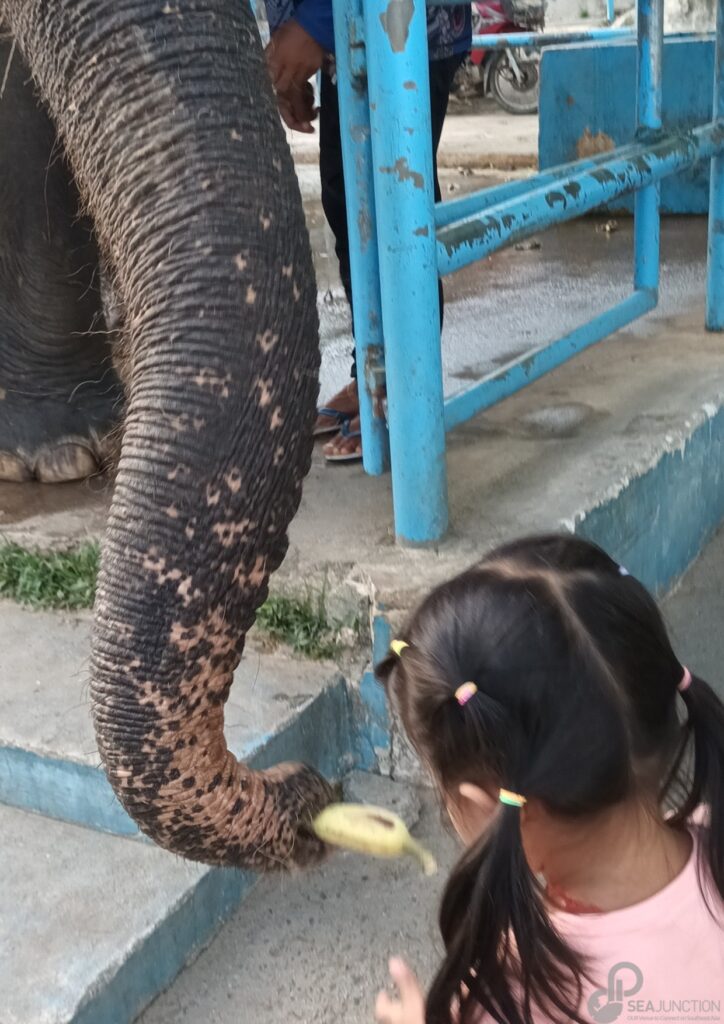
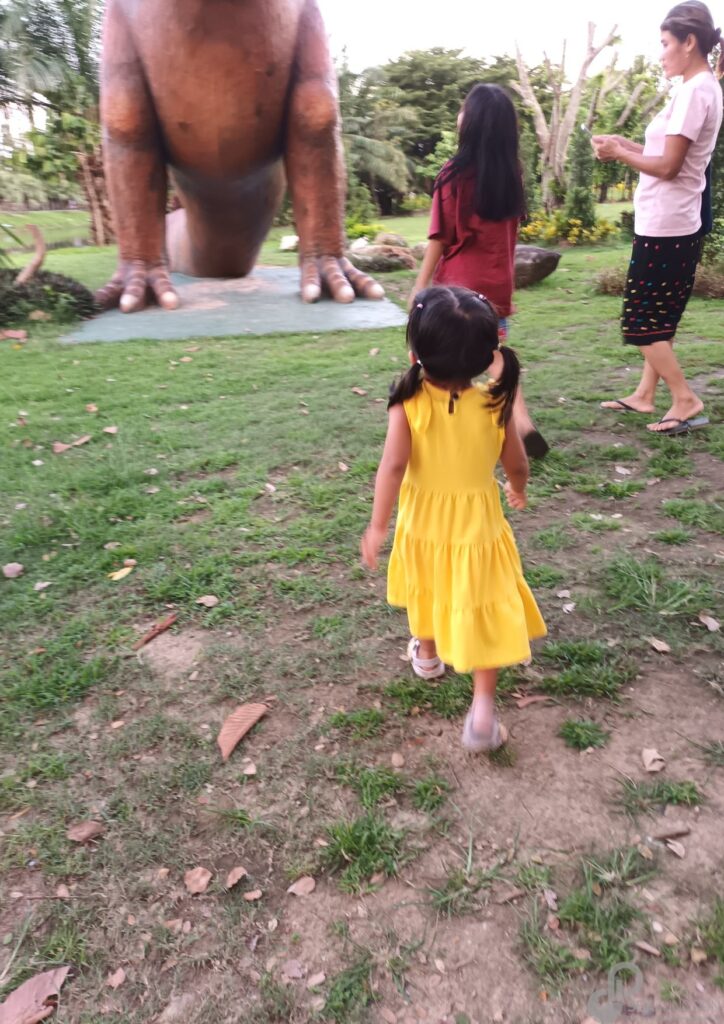
4 / Ngeth Sarath /
“I am a worker from Kampot. I am 43 years old and have lived in Thailand for about 20 years. I am a squid fisher, and sometimes I have to sail offshore for more than 10 days. My wife is from Prey Veng. We met in Thailand and now have two 8-year-old twin children, one lives in Kampot and one lives here. We rarely reunite as it takes a fortune for us to travel to Kampot.
“In Cambodia, we never had New Year parties because we only celebrate Songkran, so we enjoy doing it here. The photos are from the 2024 New Year party that we organized in the market with the other 40-50 Cambodian workers living in Laem Sing district. We held a fancy costume competition, with a 1st prize of 500 baht and a 2nd prize of 300 baht. The 1st prize winner was a construction worker. There was also a raffle, with gifts of at least 200 baht such as dishes, bed sheets, toiletries, and money. People were delighted to receive fans and rice but didn’t want the dishes and cups since they had them.
“A Cambodian monk from a forest temple also came and blessed us. A few Burmese migrants also participated. One of them has stayed here for a long time. He speaks Thai and Khmer and has a Cambodian wife. There are fewer fishing vessels right now, so Burmese people went to seek for jobs in Mahachai. In the past, there were only Myanmar people in the area, but now only Cambodians come here. There were almost 100 Cambodian migrants at the party coming from Rayong, Koh Proet and Bangkok. During the pandemic, we could not do anything, but this year we were all smiles, so I took the photos to remember this happy moment.”
